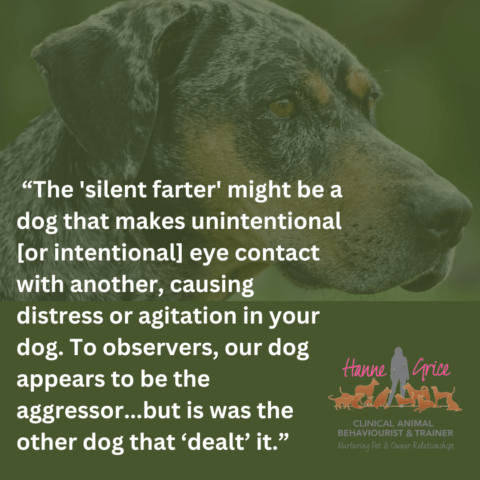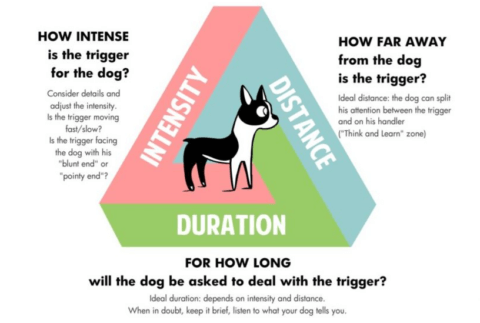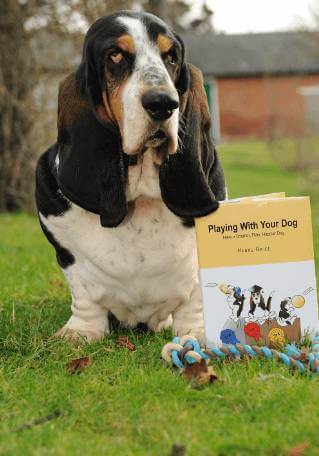As a dog owner, have you ever been baffled by your dog’s sudden outburst of reactive behaviour during a peaceful walk? Picture this familiar scene: you’re strolling with your dog, and out of nowhere, they start barking or lunging at another dog across the street. The other dog seems non-threatening, yet your dog is visibly agitated. This is where the ‘silent farter’ might be at play.

What is the ‘Silent Farter’ concept?
The ‘silent farter’ is a metaphorical term used to describe a subtle yet significant factor in dog-to-dog interactions. It refers to a dog whose mere presence, body language, or gaze might trigger a reaction in another, such as barking, lunging out on the lead, etc. While not scientific, this term helps us understand the complexities of canine communication!
Dog aggression is influenced by a myriad of factors, including medical conditions, unmet needs, environmental stressors, and handling methods, to name but a few. By observing our dogs – their body language and vocalisations like huffs, puffs, or grumbles – we can better understand their emotional responses to various situations. A dog that stiffens, stares, or emits a certain scent might unknowingly appear threatening to another dog. And, whilst our human noses are not as efficient at detecting scent changes, we can observe our dogs and others, as this helps us better predict what might happen next.
Hence, when it comes to eye contact in dogs, this is a nuanced form of communication. In human-dog interactions, sustained eye contact can strengthen the bond and promote the secretion of oxytocin (the ‘love’ hormone). However, direct eye contact can be intimidating or even threatening in dog-to-dog encounters. The ‘silent farter’ might simply be a dog that makes unintentional [or intentional] eye contact with another dog, causing distress or agitation in your dog.
Environmental influences and on-lead behaviour

Environmental elements significantly affect dog behaviour. For instance, dogs on a lead may feel more constrained, heightening the risk of over-reactive responses. The tension of being on a lead, combined with the approach of another dog, can amplify their response to perceived threats. In such scenarios, the ever decreasing distance as the dog approaches, along with the increasing duration of the eye contact, whilst being on-lead, immediately increases the intensity of that situation. This can result in our dog ‘reacting’ (e.g., barking and pulling) towards the other. Check out trainer Suzanne Clothier’s infographic which helps highlights this principle [intensity, duration, distance] at play.
To passers-by, our dog appears to be the aggressor, which can cause immense social embarrassment, but it may have been the other dog’s prolonged eye contact that prompted this strong response. Hence, the idea of the ‘silent farter’ because it was the other dog that ‘dealt’ it [the perceived threatening behaviour].
Practical advice for dog owners
When I adopted my rescue Labrador, Hattie, I discovered she was a ‘silent farter’. With patience and training, we turned this around. Recognising if your dog is a silent farter is crucial, as it can help mitigate their reactions and improve interactions with other dogs.
- Firstly, observe both dogs: Pay attention to the body language of both your dog and the other[s]. Look for signs of discomfort from either such as head turns away, lip licking, sniffing the ground, lowering body, attempting to move away, holding of breathe, increase in blink rate, shutting of mouth, etc. Check out Lili Chin’s Doggie Language book for guided illustrations.
- Secondly, give them space: When on a lead, ensure your dog and the other dog has enough space (more than you might think necessary). This can reduce the feeling of being trapped, which can otherwise escalate reactions. Practice quick turns away at home, in the garden, then progress to walks, slowly introducing distractions. Remember, space is your friend.
- Thirdly, break the eye contact: Encourage your dog to break eye contact with another. Use treats or toys to distract them. You could play the Name Game; say their name and immediately reward with something they love (treat, toy, play, strokes – whatever floats your dog’s boat!) – even tossing it slightly ahead of you so they can chase it. This helps your dog learn to disengage from the other, turn away, and move along with you.
- Finally, encourage sniffing and searching: Teaching your dog to sniff out food hides, toys, and other searching activities can break the tension when others are about. Searching and sniffing promotes calmness where we are getting them to breathe deeply in search of the hides. As their head naturally dips away, down and around, this immediately breaks any eye contact, and provides some mental stimulation. Again, practice this away from real-world situations so your dog understands what it means when you say “Find it” or whatever cue you will teach them. Then, weave in distractions slowly and at a distance. With repetition, you’ll be able to engage your dog in sniffing and searching on cue, when needed.
Key take-aways
Not all reactions can be attributed to the ‘silent farter’; after all, dog behaviour is complex and influenced by a myriad of factors. Nevertheless, understanding the ‘silent farter’ concept is key to preventing misunderstandings and managing our pets’ behaviour more effectively. By being observant and proactive, we can ensure more peaceful and enjoyable walks for both ourselves and our four-legged friends.
If you’re in need of support with your dog’s behaviour, then please check out the Animal Behaviour and Training Council (ABTC) website for a list of registered practitioners in your area.
Learn more about our classes

Get Hanne's book, clothing and more
Hanne has a number of publications including her book Playing With Your Dog to help owners work out the games that are best suited for their pet to play throughout his life, from puppyhood to old age, available from Amazon. Check out Hanne's range of contemporary casuals The Collection – for pet lovers made from recyclable, organic materials that are sustainably sourced.

